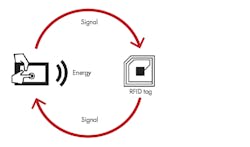Radio-frequency identification tags (RFID) have become an essential method of tracking not only shipping products, but also components in manufacturing assembly. They are currently used to control shopping, logistics, warehouses, stock, and assembly components.
RFID tags provide a more accurate and efficient way to read product serial numbers and data. Barcodes are limited in range and the amount of data they can transmit. RFIDs provide not only product identification, but also installation information.
Due to the simplicity and effectiveness of RFIDs when it comes to tracking tagged items, companies are now looking to apply the technology to digitize their assembly process. A recent case study from the Fraunhofer Institute for Factory Operation and Automation IFF in Magdeburg has highlighted how engine manufacturers are using RFIDs to optimize car assembly.
RFID Basics
RFIDs are an improvement on barcodes. RFIDs are a form of wireless communication that use electromagnetic or electrostatic coupling within the radio-frequency portion of the electromagnetic spectrum to uniquely identify an object. RFIDs consist of three major components: a scanning antenna and transceiver, transponder, and the RFID tag. The antenna and transceiver are typically in one reader known as an interrogator. The RFID tag itself has a microchip, memory board, and antenna. The reader is connected to the network and can be either a permanent fixture or temporarily attached. It uses radio frequencies to transmit its identification signals. Once activated, the tag sends radio waves back and forth between the network and object to translate data.
Passive RFID tags receive energy from the reading antenna device
There are two types of RFID tags: active and passive. Active tags require a power source, while passive tags receive power from the reading antenna. The electromagnetic wave induces a current in the RFID tag’s antenna. RFID tags typically hold less than 2,000 KB of data. The data includes serial numbers and other product information. The read range for the tags varies depending on the type of tag, reader, frequency, and interface.
RFID tags operate on four different systems: low frequency (LF), high frequency (HF), ultra frequency (UHF), and microwave frequencies. LF RFID systems range from 30 kilohertz (kHz) to 500 kHz, with the typical frequency being 125 kHz. LF RFID has short transmission ranges, from a few inches to less than six feet. HF RFID systems range from 3 megahertz (MHz) to 30 MHz, with the typical frequency being 13.56 MHz. The standard range is from a few inches to several feet.
UHF RFID systems range from 300 MHz to 960 MHz, with a typical frequency of 433 MHz. UHF has a longer read range and can generally be read from 25-plus feet away. Microwave RFID systems run at 2.45 gigahertz (GHz) and have the longest read range of more than 30-plus feet away. The frequency used will be based on the application and operating conditions.
RFIDs have advantages over barcodes, since they can read without direct line of sight. They can identify many more items at a time, and are able to scan items from anywhere to a few inches or feet away. Read time on an RFID tag takes less than 100 milliseconds. RFID tags are also read/writable, while barcodes are limited in terms of reuse. RFID tags are rugged and better protected, often housed in a plastic cover. The downside is that RFID tags are more expensive than barcodes.
Using RFIDs in Vehicle Assembly
Customization in vehicle manufacturing poises major challenges for carmakers. For example, a seatbelt for German cars can appear similar to one installed in non-EU cars. To modernize the process, many companies are using RFIDs to free their employees from routine tasks and provide the ability to perform automatic inspection simultaneously to ensure that they installed the correct parts.
"Radio-frequency identification or RFID tags on parts can boost process reliability and efficiency significantly," says Marc Kujath, research scientist at the Fraunhofer IFF. Researchers from the Fraunhofer Institute for Factory Operation and Automation IFF in Magdeburg are readying manufacturing and supply-chain operations for digitization and helping to refine their assembly process for the world of the Internet of Things (IoT). Kujath goes on to say, "We have demonstrated this in feasibility studies and wireless tests conducted jointly with Mercedes-Benz Vans at their factory in Ludwigsfelde near Berlin."
Interconnected technologies boost process reliability in manufacturing. First, side mirrors and seats were tagged with RFID tags in a pilot phase. (Courtesy of Fraunhofer IFF, Andreas Süss)
The first step of implementing the tags was to determine which parts were best suited for the tags, and 40 different parts wound up being identified. The experts initially focused on mirrors and seats for further developments.
The RFID tags are attached to every single safety-critical part, such as rear-view and side-view mirrors. The RFID stores the serial number and delivers abundant information; for example, the vehicle in which a mirror is to be installed. Barcodes cannot store that type of information, and have to be read manually one at a time using a handheld scanner. RFID tags can all be read automatically and optically at the same time by one scanner. This is still possible even after the parts are installed.
The ability to read all of the tags at one time is a crucial advantage for manufacturing—it simultaneously provides part installation verification while a front or rear axle is being installed. Previously, proper part installation would not be performed until final inspection, which involved employees conducting visual inspections and using paper lists.
The researchers from the Fraunhofer IFF helped car manufacturers by delivering the technology and the operating specifications. "This required several steps, which we tackled together with our partner Mercedes-Benz Vans,” says Kujath. “For instance, we reduced the blind spots in production scheduling. This means that a project manager now knows where the snags in the process are located – and can ask the right questions at the right time."




